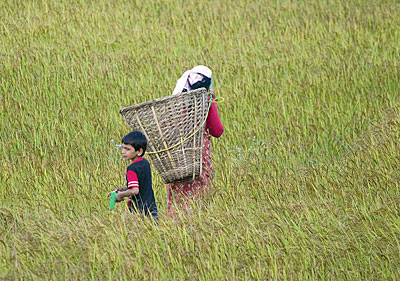 |
World Food Day, a global event meant to raise awareness and stimulate action on hunger, fell right in the middle of our festival of gluttony this year. Nepal's country-seat at the FAO headquarters in Rome was empty as the '1 billion hungry' project was launched. About 4 million of those hungry people are here in Nepal.
Food is basic. Our life and livelihoods are planned around it, if not only for it. It starts from the moment you open your eyes and ends with the big supper at the end of the day when you tell friends and family about the day that has passed.
But imagine waking up everyday with the pain of hunger pangs. Whether you dine at your local momo station or at Soaltee's Al Fresco might be an indicator of status for some but for others, a meal becomes a matter of life and death.
Smart agricultural policies actually go beyond fulfilling this basic need. The World Bank estimates that growth in the agricultural sector is twice as effective in reducing poverty as growth in other sectors. Brazil and China rose to become important powers in the world arena only after a successful implementation of green revolution techniques to boost agricultural yields. Despite similar gains, India, while enjoying comparable economic growth and technological advances in many areas, is still bogged down by the predicament of how to feed the 421 million who live below the poverty line.
That political parties are trying to outdo each other with creative food and agricultural policies is a sign of how seriously India takes the issue. The message is clear. A country needs to feed its people, or, as the President of the International Fund for Agricultural Development said in Rome last week, "it has no right to sovereignty."
There are some examples we can learn from. After the 1994 genocide it looked like Rwanda would take decades to heal its wounds and get on the path to successful nationhood. With an aggressive program to boost production through use of improved seeds, better crop husbandry, and the merger of small farms for better yields, Rwanda has made incredible progress in the agricultural sector. In 2007, agricultural growth reached 15 per cent, up from 0.7 per cent in 2006. Rwandan coffee exports rose from zero to USD 8 million between 2001 and 2006. An average Rwandan now receives 2,176 calories a day, a remarkable shift from its pre-green revolution calorie intake of 1,000.
What worked for China and Rwanda will not work for Nepal for, along with land ownership issues, agriculture is not free from the shackles of politics and bureaucracy. Infrastructure is key, storage and drying facilities are needed, and when production is ample, farmers need to be connected to the market. Jumla may produce juicy apples but it will be of no use to them and the nation if only Chinese apples find their way to consumers in Kathmandu.
It boils down to the fact that 65 per cent of the population depend on agriculture for their livelihood and one third of GDP is attributed to agriculture. A successful development strategy should take these numbers into account and boosting food production should be an important national policy. As much as breakfast is necessary to tackle the day ahead of you, feeding the country is necessary to achieve our other national goals.
READ ALSO:
Tale of two gombas, RABI THAPA



